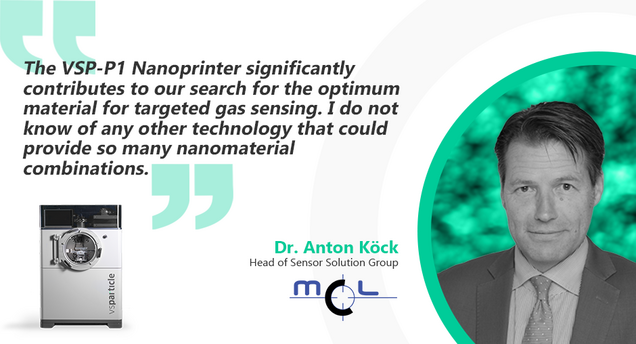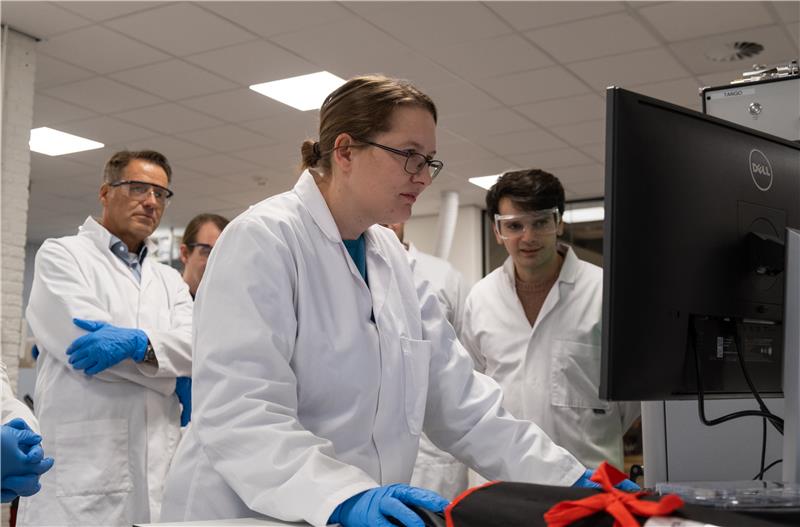Partner:
Materials Center Leoben Forschung GmbH (MCL)
Dr. Anton Köck
Head of the Sensing Solutions Group
Materials Center Leoben Forschung GmbH (MCL)
Research field:
Gas sensor development
Project:
AccSens Initiative
Technology used:
VSP-P1 Nanoprinter

Introduction
In 2023, VSParticle and MCL (Materials Center Leoben Forschung) joined forces in the AccSens project, combining machine learning with nanoprinting technology to accelerate the discovery and optimization of sensing materials.
Within the AccSens project, we collaborate closely with dr. Anton Köck and his team of researchers.
Dr. Anton Köck is a physicist with 20 years of experience in the field of chemical nanosensors and advanced material development. He currently leads the Sensing Solutions Group at the Materials Center Leoben Forschung GmbH (MCL).
We have asked dr. Köck about his experience integrating the VSP-P1 Nanoprinter into his research.
Dr Köck, how does VSParticle's nanoprinting technology contribute to the AccSens project?
In the AccSens project, our primary objective is to optimize sensor performance – particularly selectivity – by experimenting with specific nanomaterial combinations. The VSP-P1 Nanoprinter offers a unique flexibility in depositing a variety of different nanomaterials. This capability is instrumental to our search for the optimum material combination for each specific target gas, such as formaldehyde, acetone, or carbon dioxide.
How do the nanoporous layers (NPLs) created with VSParticle nanoprinting technology improve the performance of sensor arrays?
The nanoporous layers optimize both the sensitivity and selectivity of our sensors. Their high surface-to-volume ratio results in strong responses to target gases, while selecting the right nanomaterial combinations enables selectivity in complex gas mixtures. Moreover, we observe that the sensor signals are very stable, indicating improved long-term stability.

Could you share any key improvements in your experimental workflow through VSParticle's technology?
The Nanoprinter significantly accelerates our experimental workflow by allowing us to rapidly test a huge variety of nanomaterials and combinations. Its most valuable contribution is the flexibility in combining different nanomaterials. To the best of my knowledge, no other technology currently provides this level of versatility for systematic material exploration and sensor optimization.
How does the flexibility in mixing and combining materials contribute to the team's project goals?
We can easily mix up to 4 different materials, such as Cu, Sn, Ni, and Au, and any combination thereof. This level of flexibility is not feasible with traditional methods like sputter deposition. As a result, we have gained a lot of knowledge about the nanomaterials we should use for the specific target gases to achieve an outstanding sensor performance.
How would you compare VSParticle’s nanoprinting technology to other methods used for depositing sensing layers on devices?
At MCL, we use spray pyrolysis technology to deposit MOx films on sensor devices. This technology requires additional processing steps, such as photolithography and reactive ion etching, to structure the sensor device. These steps introduce the risk of contamination of the sensing films, which could be detrimental to the sensor performance. In contrast, the Nanoprinter allows direct deposition of pure materials without the need for any additional post-processing – an advantage that is very important in gas sensing!
How does the nanoprinting technology support the development of multiarray gas sensors?
With this nanoprinting technology, fabricating multi-sensor arrays is much easier because each sensor device can be coated with a specific nanomaterial combination optimized for the target gases. This enables high versatility in fabricating multi-sensors for customer-specific applications.

VSP-P1 Nanoprinter
The VSP-P1 Nanoprinter enables you to locally print inorganic nanostructured materials with unique properties. The building blocks for the printed layer are gas-phase produced, sub-20 nm nanoparticles, free of surfactants or any other organic impurities. With the VSP-P1 NanoPrinter, semi-automated printing of nano porous layers of different composition and/or layer thicknesses is possible.
Contact us to learn more about the product and its applications.